Current issue
Displaying 1-5 of 5 articles from this issue
- |<
- <
- 1
- >
- >|
-
2024 Volume 4 Issue 1 Pages 1-
Published: January 31, 2024
Released on J-STAGE: March 07, 2024
Download PDF (386K) -
2024 Volume 4 Issue 1 Pages 2-23
Published: January 31, 2024
Released on J-STAGE: March 07, 2024
Download PDF (2245K) -
2024 Volume 4 Issue 1 Pages 24-34
Published: January 31, 2024
Released on J-STAGE: March 07, 2024
Download PDF (2551K) -
2024 Volume 4 Issue 1 Pages 35-46
Published: January 31, 2024
Released on J-STAGE: March 07, 2024
Download PDF (651K) -
2024 Volume 4 Issue 1 Pages 47-
Published: January 31, 2024
Released on J-STAGE: March 07, 2024
Download PDF (443K)
- |<
- <
- 1
- >
- >|
